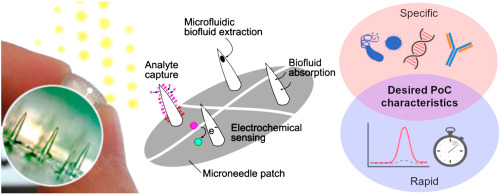We have published a review article on microneedles as a technological platform for diagnosing infectious diseases. In this review, we enumerate the infectious diseases that could potentially be diagnosed in the skin, examine the mechanisms of existing microneedle diagnostic technologies, and evaluate their applications in infectious disease diagnosis. This publication is timely given that we’re in the middle of a infectious disease pandemic.

Any diagnostic test has to be specific to be useful (Figure 1). For a potentially deadly diseases, the more rapid the diagnosis, the better, because it buys precious time for the patient to seek early treatment, which could save lives. However, for infectious diseases that can be transmitted by close contact, it’s also desirable that the patient can administer the test themselves without too much discomfort. Many tests do better in meeting some of these criteria at the expense of other criteria. For example, I took the PCR test for COVID-19. I am sure the test itself was highly specific, but the nasal and throat swabs were uncomfortable. The diagnosis wasn’t exactly ‘rapid’ either — I got my result several days later (mainly due to limited test capacity at that time, but that has improved significantly since). Microneedle devices are painless to administer on the skin, and tests can produce real-time or near-real-time results. Not all of these studies have been on infectious diseases, of course. The technology is still nascent but the potentials are huge.
The review article is currently in press, but a pre-proof is already available for download from Acta Pharmaceutica Sinica B. There have been a number of minor corrections to this pre-proof (mainly typographical and referencing error) which will appear in the final publication, but the pre-proof should satisfy the impatient for now.
Congratulations to everyone involved in putting this publication together.

